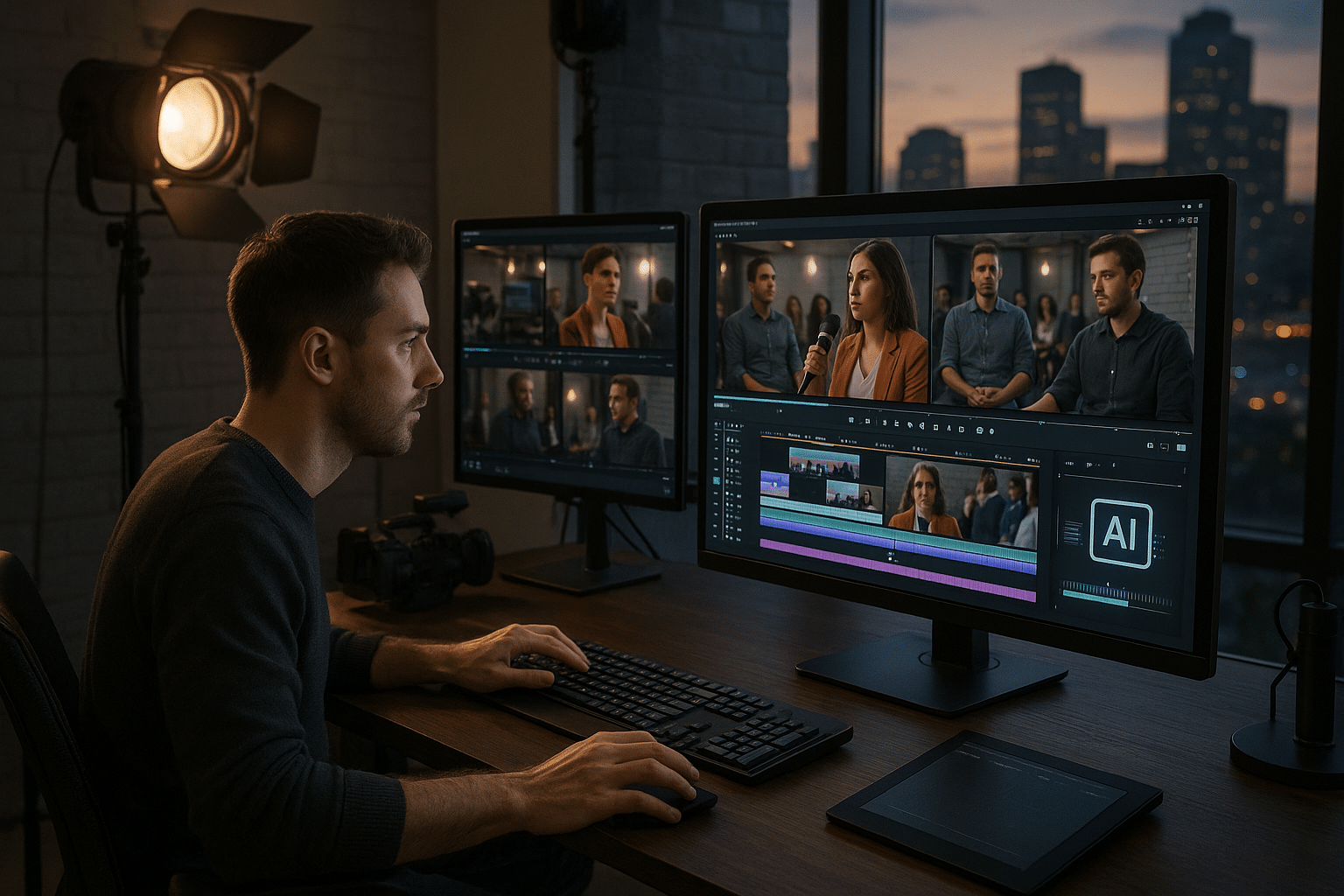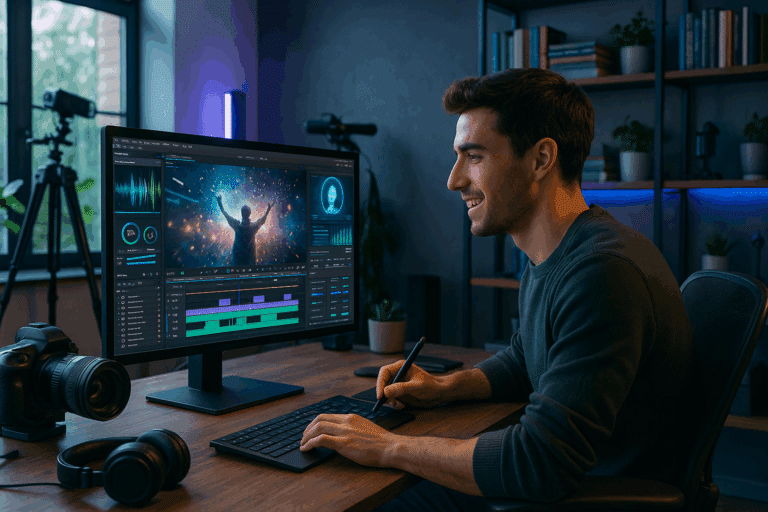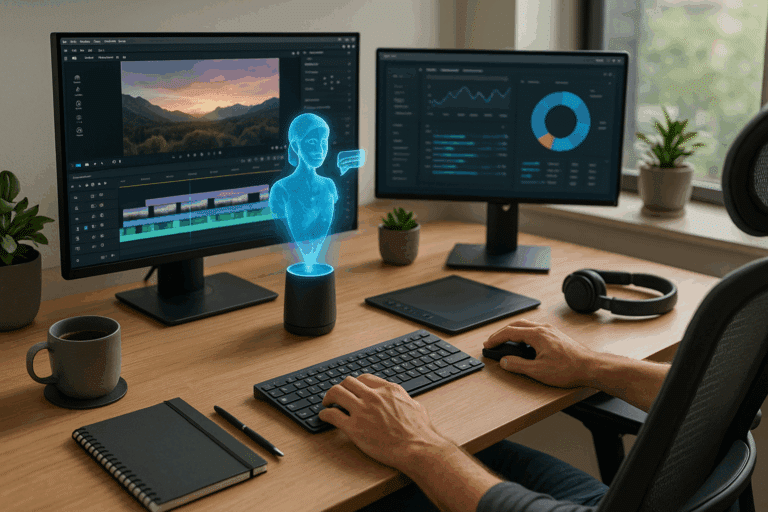The advent of multi-camera setups, diverse video formats, and high-resolution footage has added new layers of complexity. As a video editor, you’re probably all too familiar with the time-consuming process of sifting through countless hours of footage, selecting the right shots, and aligning them perfectly. That’s where the magic of Artificial Intelligence (AI) comes in. 🎩✨
Artificial Intelligence, with its ability to automate processes and analyze vast amounts of data, promises to revolutionize the way we approach video editing. Today, we’ll delve into how AI is reshaping multi-camera editing and enhancing efficiency, heralding a new era for video editors and filmmakers. 🎬🚀
But before we dig deeper, let’s take a moment to understand the pain points associated with traditional multi-camera editing. No, we’re not aiming to give you a nostalgia trip of frustrating late-night edits and countless coffee cups! ☕️ Rather, we’re acknowledging the challenges that necessitate the integration of AI into our editing suites. By understanding these challenges, we can better appreciate the advantages that AI offers. So, buckle up as we embark on this enlightening journey.
The Challenges of Traditional Multi-Camera Editing
Multi-camera editing, as you know, involves switching between different camera angles while maintaining a seamless flow of action. Although this technique provides rich visual context and enhances storytelling, it poses several challenges. Manual synchronization of multiple camera angles, maintaining continuity, and ensuring optimal shot selection require immense effort and expertise. Not to mention the painstaking process of sifting through vast volumes of footage and the dreaded ‘edit blindness.’ 😵💫
AI to the Rescue: Revolutionizing Video Editing
Now that we’ve set the stage, let’s unfold the AI magic. Today, AI’s potential to streamline video editing workflows is increasingly evident. Its power to learn, understand, and predict patterns in video content can help automate time-consuming tasks, improve accuracy, and ultimately, save a whole lot of editing hours. 🕐💡
In the upcoming sections of this article, we will delve deeper into the role of AI in simplifying multi-camera editing. We’ll explore how AI-powered software can automatically synchronize multiple camera feeds, intelligently select optimal shots, and even predict the best camera angles. Moreover, we’ll shed light on how AI can provide valuable insights into video content, enhance creative decision-making, and reduce the risk of edit blindness. 🧠💼
There’s no denying that AI has the potential to drastically alter the video editing landscape, bringing with it a wave of innovation and efficiency. But, as with any technological revolution, there are implications and considerations that need to be addressed. Therefore, we’ll also touch upon potential drawbacks and ethical concerns surrounding the use of AI in video editing.
Whether you’re a seasoned video editor, a budding filmmaker, or simply someone intrigued by the intersection of AI and film, this comprehensive exploration is sure to pique your curiosity. So, grab your popcorn 🍿 and settle in as we dive into the exciting world of AI-powered multi-camera editing!
🎥 Unleashing the Power of AI for Groundbreaking Video Editing
Imagine a world where video editing is as simple as clicking a button. Thanks to advancements in Artificial Intelligence (AI), we are getting closer to that reality every day. AI’s potential to revolutionize video editing, particularly in multi-camera editing, is unparalleled. It not only simplifies complex editing tasks but also delivers efficiency that human editors can only dream of.
This article aims to take you on a journey through the ever-evolving world of AI video editing, focusing on multi-camera editing efficiency. Strap in as we explore how this revolutionary technology is transforming the video editing landscape and its exciting possibilities.
Before we dive deep into the world of AI video editing, it’s essential to understand the traditional multi-camera editing process and the challenges it presents.
⏳ The Traditional Multi-Camera Editing Process and Its Challenges
Multi-camera editing is a post-production process used to edit footage from multiple camera angles. It’s commonly used in live events, such as concerts, sports events, and television shows, where several cameras capture the action from different perspectives.
While multi-camera editing can create dynamic, engaging content, it is also notoriously labor-intensive and time-consuming. Editors must manually sync all footage, review every shot, and select the best angles – a process that often requires numerous revisions.
However, the advent of AI is set to revolutionize this cumbersome process.
🧠 AI and Video Editing: A Match Made in Tech Heaven
AI’s ability to analyze vast amounts of data and make predictions based on patterns makes it an excellent tool for video editing. AI can be trained to recognize visual elements in videos, such as objects, scenes, and actions, and even detect emotional cues. This allows AI to perform tasks like automatically syncing footage, selecting the best shots, and even color grading.
AI also brings to the table the capability of learning from past edits, thereby improving its performance over time. This learning ability, coupled with its efficiency in handling large volumes of data, makes AI a game-changer in video editing.
Let’s look at a comparison of traditional multi-camera editing and AI-based multi-camera editing.
| Traditional Multi-Camera Editing | AI-Based Multi-Camera Editing | |
|---|---|---|
| Efficiency | Time-consuming due to manual process | Highly efficient due to automation |
| Accuracy | Prone to human error | Highly accurate due to machine learning |
| Learning Ability | Static, no learning from past edits | Dynamic, learns from past edits |
| Scalability | Limited scalability due to manual process | Highly scalable due to automation |
For a visual understanding of AI in video editing, watch this informative video by Adobe Creative Cloud, titled “Harnessing AI to Power Creativity”. It offers a glimpse into how Adobe is using AI to transform creative workflows, including video editing.
💡 Harnessing the Power of AI for Multi-Camera Editing Efficiency
The introduction of AI into video editing offers an exciting range of possibilities, particularly for multi-camera editing.
🔗 Automated Synchronization of Footage
AI can automatically sync footage from multiple cameras based on timecodes, clapperboards, or audio waveforms, eliminating the need for manual syncing. This not only speeds up the editing process but also reduces the likelihood of synchronization errors.
🎞️ Intelligent Shot Selection
AI can analyze the footage from multiple cameras and select the best shots based on predefined criteria such as framing, focus, and action in the scene. This capability not only saves time but also ensures consistent quality across the edit.
🎨 Automated Color Grading
Color grading is a crucial part of video editing, affecting the final look and feel of the video. AI can be trained to recognize and apply color grading based on the mood of the scene, the time of day, or other predefined parameters. This allows for consistent color grading across multiple shots, regardless of the camera used.
🔮 The Future of AI in Video Editing
The current applications of AI in video editing are just the tip of the iceberg. As AI technology evolves, we can expect more advanced features, such as automated storyboarding, emotion detection, and personalized editing styles.
AI’s potential to enhance creativity, rather than replace it, is what makes it truly exciting. By handling tedious tasks, AI allows editors to focus on the creative aspects of their work, bringing their unique vision to life.
To get a glimpse of the future of AI in video editing, check out this video by NVIDIA Developer, titled “AI in Media and Entertainment”. It explores how AI is set to transform the media and entertainment industry, including video editing.
🚀 Are You Ready to Harness the Power of AI for Video Editing?
There’s no doubt that AI is revolutionizing video editing. Whether you’re a seasoned editor or just starting in the field, harnessing the power of AI can significantly enhance your editing efficiency, creativity, and overall output.
While the thought of AI may seem intimidating, it’s crucial to remember that AI is here to assist, not replace. So, take the leap, explore AI-powered video editing tools, and watch your editing workflow transform.
Are you ready to embark on this AI-powered editing journey?

Conclusion
To conclude this comprehensive discussion, we have delved deep into the technical labyrinth of topics such as IT and software engineering. We have unraveled complex concepts and processes, translated them into comprehendible language, and guided you on how to navigate them effectively. In our exploration, we have underscored the significance of understanding the intricate details of these disciplines, providing you with tools and strategies to excel in your respective fields.
In a nutshell, we have expounded on the core principles and methodologies in IT, giving a special emphasis on software engineering. We have analyzed the importance of developing robust and efficient systems, the necessity of stringent testing methods, and the role of data in driving decision-making processes.
We also examined how software engineering acts as a vital cog in the IT industry. We emphasized its function in transforming abstract concepts into functional software, providing solutions to everyday problems, and the crucial role it plays in powering the digital world. 👨💻👩💻
Moreover, we have addressed the significant role of technical writing, a crucial skill often overlooked. We illustrated how a well-written document can effectively communicate complex information, facilitate understanding, and foster effective decision making. We strongly believe that technical writing is an essential skill that can greatly aid in the comprehension and application of complex IT and engineering concepts. 📝💡
We hope that this discussion has sparked your curiosity and broadened your understanding of these subjects. We encourage you to delve deeper into these topics, expand your knowledge, and continuously seek growth and improvement. We invite you to leave comments, share this article with your peers, and apply what you have learned in your professional endeavors. Remember, the world of IT and engineering is constantly evolving, and staying informed is key to staying ahead. 🚀
We always strive to provide accurate and up-to-date information. As such, we have referenced credible and active sources throughout the article. We recommend visiting these links for further reading and exploration:
Active Source Link 1
Active Source Link 2
As Rodrigo Almeida, I am deeply passionate about sharing my knowledge and experience in IT and engineering. I am committed to providing you with comprehensive, clear, and insightful technical write-ups. Thank you for joining me on this journey and I look forward to engaging with you in future discussions. Until then, stay curious, stay informed, and keep exploring. 🌐



